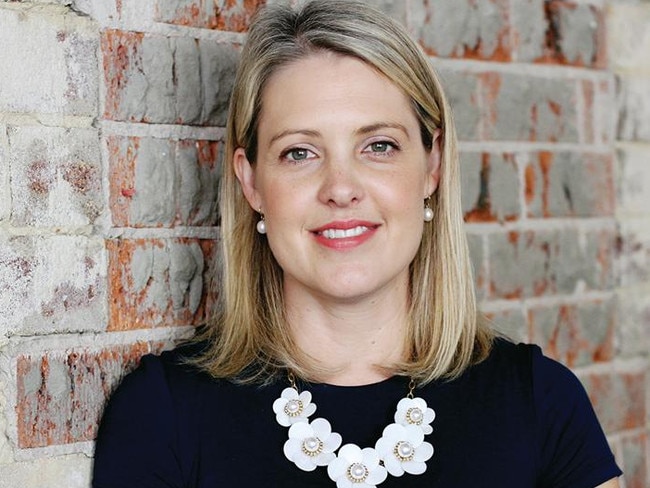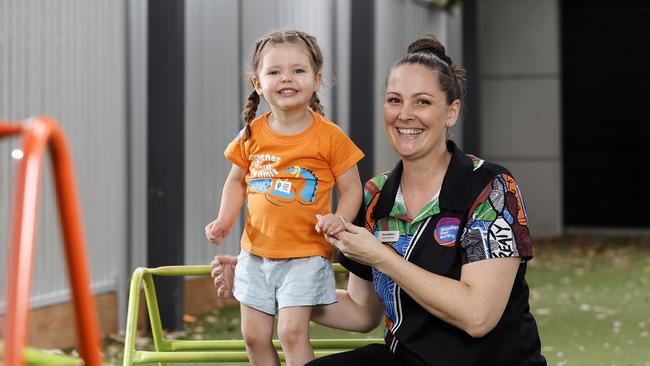Where you can find cheaper childcare in Australia as prices rise to $124 a day
As childcare fees soar again to on average $124 a day, experts say there are ways to find a cheaper deal. See the full list of prices and tips on how to save.
National
Don't miss out on the headlines from National. Followed categories will be added to My News.
Exclusive: Childcare centre fees across Australia have risen on average to $124 a day before subsidies – or more than $32,300 a year – if a child attends five days a week.
But experts say there are a range of ways parents can save money if they choose a centre that best suits their family’s needs.
KindiCare, a childcare comparison website and app, has released its latest data on fees, which reveals the ACT is the most expensive place to live when it comes to childcare fees, averaging $134.76 a day before subsidies.
It is closely followed by Victoria ($131.43), WA ($125.25), NSW ($125.10), SA ($123.09), and Queensland ($116.38). With the NT ($110.17) and Tasmania ($104.83) markedly cheaper.
The latest data also shows what the average fees are for your suburb and whether childcare in a neighbouring suburb or one on the way to, or near the workplace is more ecomonical.
KindiCare founder Benjamin Balk said he also used the data to compare private and not-for-profit community managed services and found that for profits were only four per cent more expensive on average, or $4.82 a day.
“From a parent point of view, whether a not for profit provider or for profit provider is better suited to the family will come down to what they value,” Mr Balk said.
“For profit providers tend to invest more capital into the quality of facilities and environment as an example, as they are competitive businesses operating in a commercial environment and need to attract and maximise enrolments.
“Not for profits may have an ethos or philosophy that is important to a family.”
See the list of childcare fees in every state below:
Mr Balk said the main tip for parents is that with very little difference in fees between the two main types of providers, it’s important to look at the quality of curriculum and teachers, what’s included in the fees such as nappies, food and formula, what extra-curricular and health services might be provided such as speech pathology or music lessons, and what the facilities and learning environment is like.
He said parents can shave costs on childcare fees by choosing a centre which most suits the needs of the family.
He said part-time workers needing fewer hours, may be able to take advantage of shorter session times. Parents working different hours, should look at whether one can drop off and the other who may have started earlier, pick up.
If that’s a possibility, it’s important to find a suitable centre that offers shorter session times.
Some centres are flexible and offer eight, 10 or 12 hour sessions, while others have a fixed session time where parents are still billed for 12 hours, even if they use just a fraction of that.
Some centres do not charge for public holidays, while others have discounts for holidays, or booking multiple days of care and will allow parents to swap days if there’s availability.

The Parenthood executive director Georgie Dent warned that paying more doesn’t always guarantee better quality.
“It’s not always the case that the most expensive centre is the best,” Ms Dent said.
“Look at the different ratings of the centres and go and visit.
“It’s important that families feel they have a safe and nurturing environment for their children.”
Ms Dent said a third of families use a variety of different childcare options and many do so to save costs.
“Some use a mix of childcare centres and grandparents, or pre or after school sessions,” she said.
“Fostering a relationship between grandparents and grandchildren is very important to some families, but it also reduces the financial burden of early education and care.”
Ms Dent, said The Parenthood, which is an advocacy group, is calling for free, universal childcare for all children.
Child care centre manager at Goodstart in Brisbane, Kate Walburn, said parents should check how many hours of subsidies they qualify for. Once they have their allocation, staff can help them through the process of finding what works best for them.
“Talk to the staff at the childcare centre as they can help maximise those hours for parents,” Ms Walburn said.
“Also negotiate with centre directors. If we can save you money on your bills we will absolutely do it.”
Go online to search your postcode for the average long day care fee before subsidies.
‘MAXIMISE CENTRELINK HOURS’
Mum Kate Walburn is an expert when it comes to keeping down the costs of childcare fees.
Not only has she worked in the childcare industry for nearly 15 years, she is mum to Evie, three, who attends a childcare centre and she is pregnant with her second, who will also eventually join her sister.
Ms Walburn, who is a centre director in Brisbane for not-for-profit Goodstart, said before parents start investigating childcare they need to apply through Centrelink to find out how many hours of Child Care Subsidy they are entitled.
“Once you have your allocated figure, you need to maximise those Centrelink hours,” Ms Walburn said.

In her case she and her partner are entitled to 100 hours of childcare subsidies a fortnight.
She works four, 10-hour days a week, and so books Evie in for four 10-hour sessions.
Her childcare centre allows parents to choose the length of their sessions. Some centres have fixed 12 hour sessions meaning parents have to pay the full 12 hours even if their child is in care for less than that.
Ms Walburn said she has enough hours left over to add an extra day of care when she has appointments with her midwife.
She said Goodstart also gives discounts to parents who book in children for three or more days. There’s also an option to swap days in the week, as long as there’s availability.
Ms Walburn said her childcare group doesn’t charge for public holidays, which is good for her as she does not work public holidays either and so is not paying for days she does not need.
She said she also doesn’t have to worry about food, nappies and sunscreen, as that is all included in the fees.
“These things can add up, so parents should check what is and isn’t included,” Ms Walburn said.
But her biggest saving comes from being an employee.
Because of the length of time she has been with Goodstart, she gets 50 per cent off the fees before subsidies.
“In an industry that does not pay a lot, the discount is definitely helpful,” Ms Walburn said.
“It encourages me to continue working with the company because the discount is such a perk.”
HOW TO SAVE MONEY ON CHILDCARE
Benjamin Balk, behind the childcare centre comparison app KindiCare, gives his tips for saving money.
Don’t pay for more time than you need:
Some centres have a fixed session time, others are more flexible. If you are a part-time worker and only need childcare for a few hours a day then a centre that offers an eight hour session may cost you less than one that only offers 10 or 12 hour sessions. This can also benefit full-time workers or families where parents have different hours and can manage with a shorter long day care session. The best way to evaluate exactly what your family needs is to call around to see whether centres offer different sessions or even multi-day or consecutive day discounts.

Avoid paying for public holidays:
The majority of centres charge for public holidays and they can add up over the year. Goodstart, which is the largest not-for-profit childcare centre in Australia, as well as some other centres including those that are community or council-run centres often don’t charge for public holidays when you can’t put your child in care.
Save if you’re a part-time worker:
If you don’t want a five-day a week childcare service, look for a centre that is flexible. Beware that some centres make Mondays and Fridays compulsory as they’re harder to fill. Many parents don’t want to pay for Mondays because they are often public holidays and Fridays are desirable for those who like long weekends, so ask the centre director what their policy is upfront so you can compare your options.
Get a discount with a career change:
The workforce crisis means that many early learning organisations are offering great discounts for the kids of their employees, as well as a range of other incentives such as flexible hours and other financial and non-financial benefits, to encourage more to join the industry. In many cases centres will pay for their training too, including scholarships for Diploma and Bachelor level courses. Childcare in some cases can be as a little as $5 a day for those working in the industry.
Compare apples with apples:
The devil can often be in the detail when making any important decision, from both a child development and a cost perspective. When comparing early learning services, it’s important to know what’s included in the daily fee. Some centres offer nappies, linen, excursions, incursions, food, formula and other extras which are included in the daily fee. On the surface one centre may appear cheaper, but if you have to supply lunch and snacks, formula and nappies as well as supply fresh linen every day, these additional costs can add up to way more than the money saved on the daily fee, especially when you factor that the daily fee often includes generous subsidies.
Know what subsidies are on offer and budget ahead:
It’s important to know what you’ll actually pay after the child care subsidy is applied. The published fee per day is not what most families actually pay and it is expected that 96 per cent of families will save money when Labor’s new childcare subsidies come into play in July this year. Use this handy childcare fee calculator at kindicare.com.au to work out exactly what your current fees would be and how much you will pay (and save) for childcare in the second half of the year when the subsidy changes take effect.
More Coverage
Read related topics:Cost of Living




